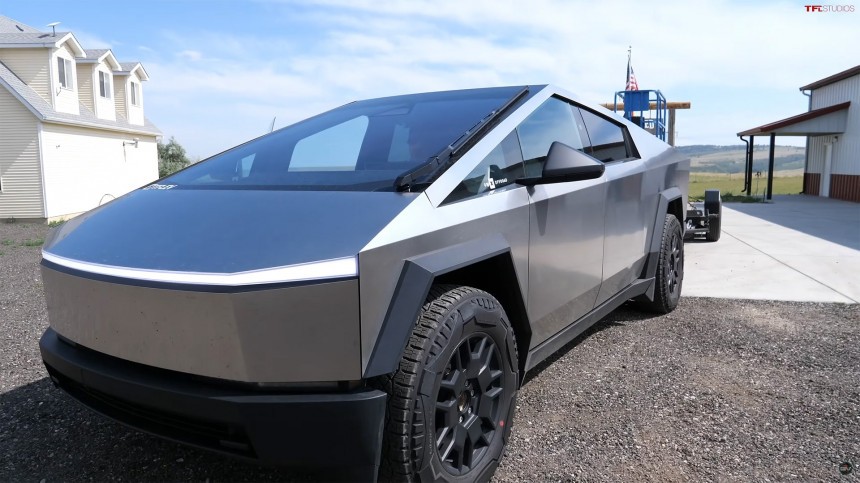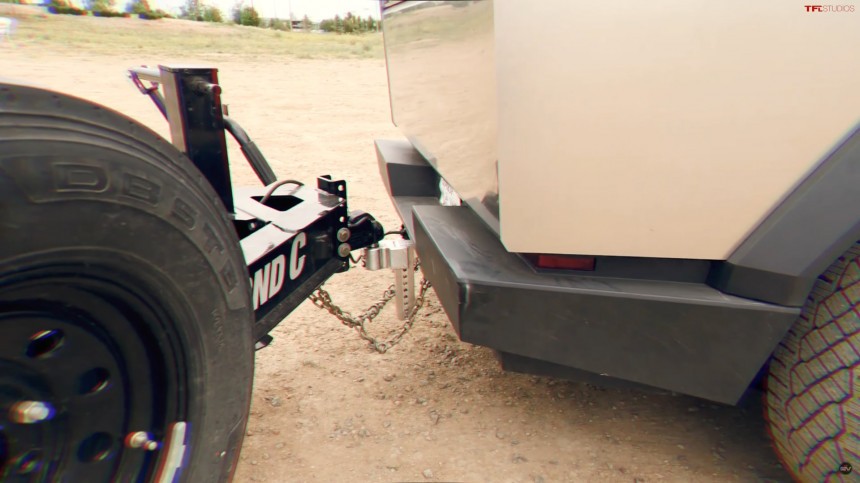What's Better at Long Range Towing, the 2025 RAM 1500 or Tesla Cybertruck?
Aside from bragging rights and being able to see the endless traffic from the highway, a pickup truck is also good for practical things like towing or looking dashing with a cowboy hat... while towing. And with the arrival of the high-torque EV pickups, the 4x4 hauling game has changed slightly. That's why all eyes and ears are wide open when a high-torque, low-rpm traditional pickup like the 2025 RAM 1500 emerges from the furnace to battle the monstrous Tesla Cybertruck EV.
Tommy and Kase from the "TFLEV" YouTube channel ran the experiment not to force the Cybertruck and RAM 1500 to blow a gasket while pulling a 30-ton weight, but to see how they perform in typical, day-to-day circumstances that anyone could find themselves in. That's why they chose a trailer with a scissor lift on top that add up to roughly 6,000 lbs. or 2,721 kilograms.
The brand-new 2025 RAM 1500 in question, called "the strongest RAM 1500 ever" by the manufacturer, has a 3.0-liter straight-six Hurricane twin-turbo powerplant capable of delivering 420 horsepower and 469 lb-ft or 635 Nm of torque. It has a TorqueFlite 8-speed auto gearbox, and under the right conditions, it can tow up to 11,560 lbs. (5,243 kg) and carry a 1,910-pound (866 kg) payload. The starting MSRP for the Tradesman version is $40,275.
However, there are 10 total trims, so let's quickly check them out. Next in line is the $41,060 Tradesman HFE, followed by the $45,230 Big Horn, $54,505 Warlock, $60,030 Laramie, $64,440 Rebel (without the $3,495 Rebel X package), $69,995 RHO, $75,450 Limited, $76,445 Limited Longhorn, and $87,320 Tungsten.
Photo: TFLEV
The new RAM 1500 comes in a trio of engine variations depending on the trim. The standard 3.6-liter V6 24V Pentastar mill produces 305 horsepower and 269 pound-feet (365 Nm) of torque, while the 3.0-liter straight-six Hurricane costs an extra $2,695.
For those who want more power, the high-output 3.0-liter Hurricane twin-turbo l6 engine delivers 540 horsepower and 521 lb-ft (706 Nm) of twist. Compared to the regular 3.0-liter powerplant, the towing and carrying power decreases to 10,770 pounds (4,885 kg) and 1,370 pounds (621 kg), respectively. That's a difference of 790 lbs. (358 kg) for towing and 540 lbs. (245 kg) for the payload.
On the other hand, we have three versions of the Tesla Cybertruck, all with 2025 delivery dates. The cheapest is the $57,390 (MSRP) rear-wheel drive model, which has a 250-mile range and a 6.5-second time from 0 to 60 mph. The one from TFLEV is the $76,390 all-wheel drive, which has an estimated 340-mile range and can hit 60 mph from a standstill in 4.1 seconds due to its 600 hp output. It also has an 11,000-lb. (4,989 kg) towing capacity and a 2,500-pound (1,133 kg) payload limit.
Finally, there's the top-of-the-line $96,390 845-hp Cyberbeast, which has an estimated 320-mile or 515-kilometer range. It's also blazing fast over the quarter mile, capable of accelerating from 0 to 60 mph in just 2.6 seconds (without rollout).
Photo: TFLEV
There are some interesting differences between the two as far as the driving experience is concernced. The RAM makes little noise when towing, while the Cybertruck's unibody form factor starts clinking and making other metal "stretching" sounds. Then, there are the mirrors. On the ICE truck, they're huge and serve better than the triangle-shaped ones from the Tesla.
The side and rearview cameras help, but then they take up the entire right side of the screen. That said, Tommy still managed to dent the rear side bumper with the trailer itself during a very tight turn. No biggie, because that allowed his dad to bang it out with a hammer, so everything was alright in the end.
Physical buttons! For example, the RAM 1500 offers buttons like the "trailer brakes" as standard, which is helpful in a pinch. The Cybertuck, however, has a lot of menus and submenus for the driver to navigate before landing in the desired settings, like the Trailer Mode. Trailer control goes to Elon's camp due to its regenerative braking, while in the RAM, you have to slam the brakes if you want to slow down, adding to the wear and tear.
The trip's purpose was to tow the 6k lbs. (2.7k kg) for 55 miles and see how both pickups performed fuel-wise. The Cybertruck started with 87% battery, or a 277-mile range on the dash. Initially, it drove with no extra weight for 35 miles using 12 kWh or 336 Wh per mile, and used 10% battery, leaving an estimated 77% or 245 miles.
Then, it hooked up to the trailer with the scissor lift on top and drove for another 56 miles or 90 km, using 38 kWh with an average of 680 Wh/mile or 1.47 miles per kWh. The battery indicator showed 44%, down from 77%, meaning it used 33%.

Photo: TFLEV
A quick math exercise would indicate that the AWD Cybertruck with 100% battery can tow around 6,000 lbs. for about 182 miles or 293 kilometers, down from the advertised regular 340-mile range.
The RAM traveled 55 miles, and its fuel economy averaged about 12.8 mpg or 18.4 liters per 100 kilometers. While they only started with half a tank, the RAM has a 33-gallon or 125-liter fuel capacity. They drove for about 55 miles or 88.5 kilometers, using less than 1/8th of a tank.
After all was towed and done, one lesson arose regarding long towing trips. The Cybertruck is like Gimli from The Lord of the Rings: a "natural sprinter, very dangerous over short distances," but "wasted on cross country."
Meanwhile, when the gas needle from the ICE-powered RAM 1500 pickup points towards E, you can easily fill it up in a matter of seconds and then be on your merry way. For this particular exercise, it's clear the 2025 RAM 1500 won the day.
